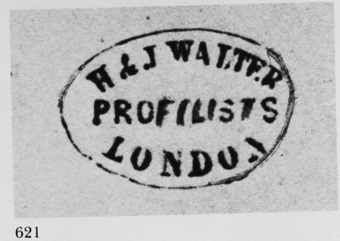Walter, Henry and Jonas (McKechnie Section 1)
Recorded by Woodiwiss (British Silhouettes), Mills (since a silhouette by the Walters was in the Wellesley collection) and Jackson (Dictionary), who lists these artists, surely erroneously, under three entries, all of which refer to the same pair of artists: Waller, H. and J.: Walter, H. and J.; and Walters, Hand [sic] J. To judge from the dress of the sitters, the available known silhouettes (which are all of women) date from c. 1848-53.
Jackson describes the Walters' work as poor, and, compared with that of artists such as John Field or even Jeffreson, their work is indeed of little artistic quality. But because of the dove-grey paper which the Walters often used, their work produces an individual and attractive impression. Some examples are cut from black paper. The Walters may have used a machine for their cutting. Embellishment, coarsely executed, is either in dead black (suggesting Indian ink), in Chinese white (sometimes tinted to a bluish- grey), or in gold (rather deep in colour). Woodiwiss refers to violet-coloured trimmings, probably painted in body colour against black, on a profile of a woman. He also mentions an example cut from two sheets of black paper, stuck together to make good an error in the cutting of the features. No doubt one of the sheets was damaged, and the duplicate was placed behind it to perfect the outline; this might suggest that the Walters kept a duplicate book.
Full-length pieces are normally either placed against a roughly sketched base, or stuck to card without a base at all. Bust-length examples are almost half-length, and the waist-line is shown. The termination is always wide, since these artists were working at a time when the width of women's skirts was approaching the extremity which was reached with the introduction of the crinoline in 1856.
Frames are usually of rosewood, with a gilt surround. One example has a mount with the domed top which was popular at this period.
Though no profile of a man is currently available, Woodiwiss owned a full-length example (recorded in British Silhouettes), and I have seen a bust-length example. Both were of the dove-grey paper already mentioned, and embellished in the same way as the illustrated silhouettes of women. On the example owned by Woodiwiss the stock was painted in black (probably Indian ink).
Only one label is known (a stencil; illustrated). This is recorded by Jackson in her entry on 'Walters, H. and J.'. An embossed stamp is also recorded as having been seen on the corner of a bust-length profile of a man, cut from black paper, touched both with gold and (on the hair) with grey paint.
Under 'Walters, Hand J.', Jackson notes a signature on a full-length silhouette of a woman which she dates to 1848.
Ills. 149, 617-621

Unknown woman
Cut silhouette, with detail painted in Chinese white, gold and Indian Ink
c. 1848-50
4 1/8 x 2¾in./105 x 70mm.
Stencil
Frame: rosewood, with gilt surround
Cut from dove-grey paper. The cap is painted in greyish-white, the collar in dead white, and the rest of the detail in gold or black.
Author’s collection

Unknown girl
Cut silhouette, with detail painted in dove-grey and gold
c. 1850
3 1/8 x 2¾in./80 x 70mm.
Stencil
Frame: rosewood, with gilt surround
Cut from black paper. With the Walters’ stencil.
D. S. Patton collection

Unknown woman
Cut silhouette, with detail painted in Chinese white and black
c. 1850-52
9 x 6in./220 x 153mm.
Stencil
Cut from dove-grey paper. The likely date is suggested by the ‘tails’ of the indoor cap.
From the collection of the late J. C. Woodiwiss

Unknown woman
Cut silhouette, embellished with gold
1853
9 x 6in./229 x 153mm.
Stencil
Cut from black paper. The likely date is suggested by the engageantes worn by the sitter at the wrist.
From the collection of the late J. C. Woodiwiss

Stencil of H. and J. Walter (from the reverse of the silhouette illustrated in 617).
Author’s collection
